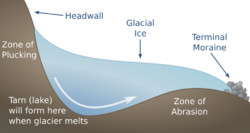Tarn (lake)
Topic: Earth
 From HandWiki - Reading time: 4 min
From HandWiki - Reading time: 4 min
A tarn (or corrie loch) is a mountain lake, pond or pool, formed in a cirque excavated by a glacier. A moraine may form a natural dam below a tarn.[1]
Etymology
The word is derived from the Old Norse word tjörn ("a small mountain lake without tributaries") meaning pond. In parts of Northern England – predominantly Cumbria (where there are 197),[2] but also areas of North Lancashire and North Yorkshire – 'tarn' is widely used as the name for small lakes or ponds, regardless of their location and origin (e.g. Talkin Tarn, Urswick Tarn, Malham Tarn).[3] Similarly, in Scandinavian languages, a tjern or tjørn (both Norwegian) or tjärn or tärn (both Swedish) is a small natural lake, often in a forest or with vegetation closely surrounding it or growing into the tarn.
The specific technical use for a body of water in a glacial corrie comes from high number of tarns found in corries in the Lake District, an upland area in Cumbria.[4] Nonetheless, there are many more bodies of water called 'tarn' in the Lake District than actually fit this technical use.
Formation
Tarns are the result of small glaciers called cirque glaciers. Glacial cirques (or 'corries') form as hollows on mountainsides near the firn line. Eventually, the hollow in which a cirque glacier develops may become a large bowl shape in the side of the mountain, caused by weathering, by ice segregation, and as well as being eroded by plucking. The basin will become deeper as it continues to be eroded by ice segregation and abrasion.[5][6] A cirque typically will be partially surrounded on three sides by steep cliffs, with a fourth side a form of moraine constructed from glacial till, which forms the lip, threshold or sill,[7] from which either a stream or glacier will flow away from the cirque.
Tarns form from the melting of the cirque glacier. They may either be seasonal features as supraglacial lakes, or permanent features which form in the hollows left by cirques in formerly glaciated areas. [4]
Gallery
Veľké Hincovo, Tatra Mts, the largest and deepest tarn in Slovakia
Lakes of the Clouds, below Mount Washington in the White Mountains
See also
References
- ↑ "Illustrated Glossary of Alpine Glacial Landforms". http://www.uwsp.edu/geo/faculty/lemke/alpine_glacial_glossary/glossary.html.
- ↑ "Tarn Dipping blog. List of the 197 Tarns in the Lake District, Cumbria". 15 March 2016. https://lakelandrambler.wordpress.com/2016/03/15/tarn-dipping-blog-list-of-the-197-tarns-in-the-lake-district-cumbria/.
- ↑ "Fresh Water Tarns". Cumbria Wildlife Trust. http://www.wildlifetrust.org.uk/cumbria/Surveys/What%20is%20a%20Tarn.htm.
- ↑ 4.0 4.1 Evans, Ian; Cox, Nick (1995). "The form of glacial cirques in the English Lake District, Cumbria". Zeitschrift für Geomorphologie 2 (39): 175-202. doi:10.1127/zfg/39/1995/175. Bibcode: 1995ZGm....39..175E.
- ↑ Johnny W. Sanders; Kurt M. Cuffey; Jeffrey R. Moore; Kelly R. MacGregor; Jeffrey L. Kavanaugh (2012). "Periglacial weathering and headwall erosion in cirque glacier bergschrunds". Geology 40 (9): 779–782. doi:10.1130/G33330.1. Bibcode: 2012Geo....40..779S.
- ↑ Rempel, A.W.; Wettlaufer, J.S.; Worster, M.G. (2001). "Interfacial Premelting and the Thermomolecular Force: Thermodynamic Buoyancy". Physical Review Letters 87 (8): 088501. doi:10.1103/PhysRevLett.87.088501. PMID 11497990. Bibcode: 2001PhRvL..87h8501R.
- ↑ Evans, I.S. (1971). "8.11(i) The geomorphology and Morphometry of Glacial and Nival Areas". in Chorley R.J. & Carson M.A.. Introduction to fluvial processes. University paperbacks. 407. Routledge. p. 218. ISBN 978-0-416-68820-7. https://books.google.com/books?id=X_ENAAAAQAAJ&q=cirque+geomorphology&pg=PA157. Retrieved 2010-01-24.
External links
 Media related to Tarn (lake) at Wikimedia Commons
Media related to Tarn (lake) at Wikimedia Commons
de:Karsee
 |
 KSF
KSF












